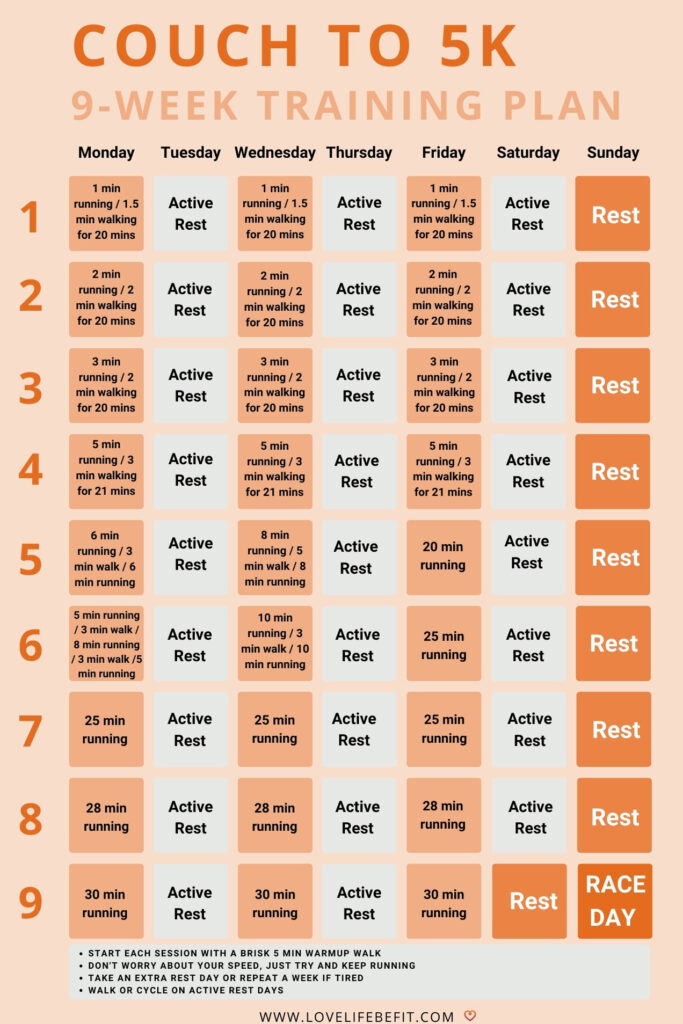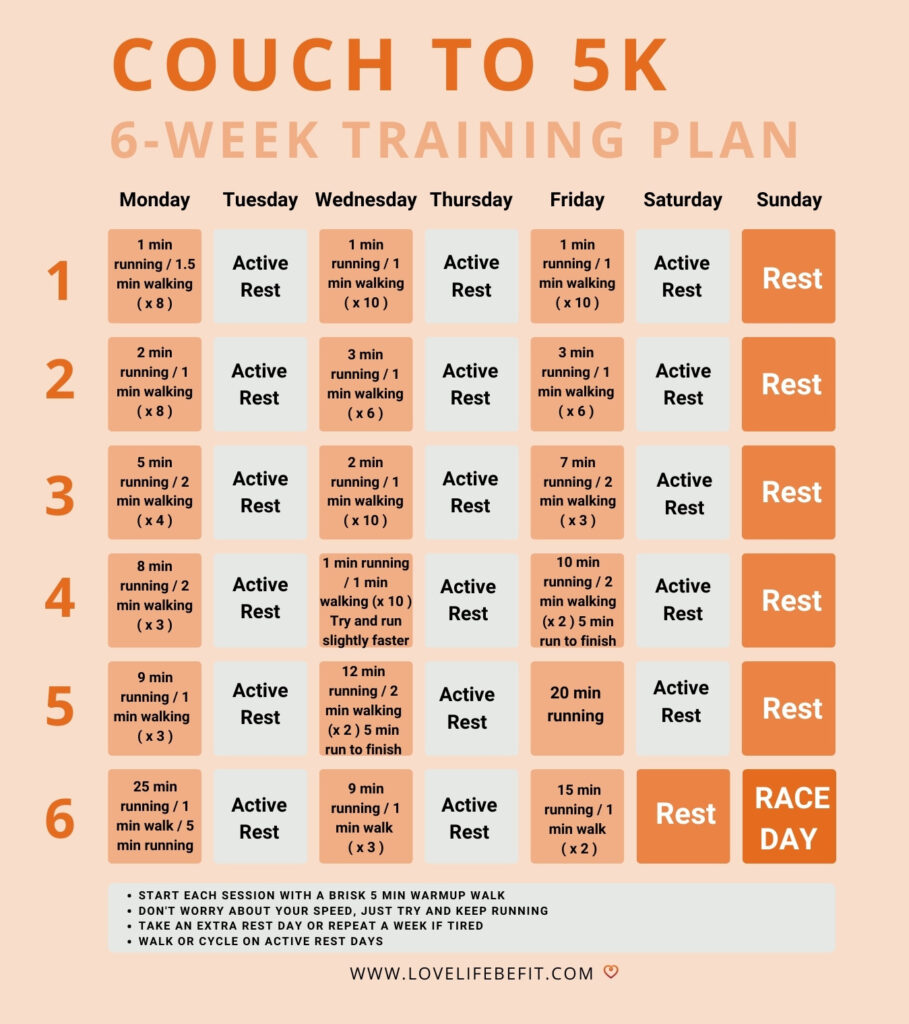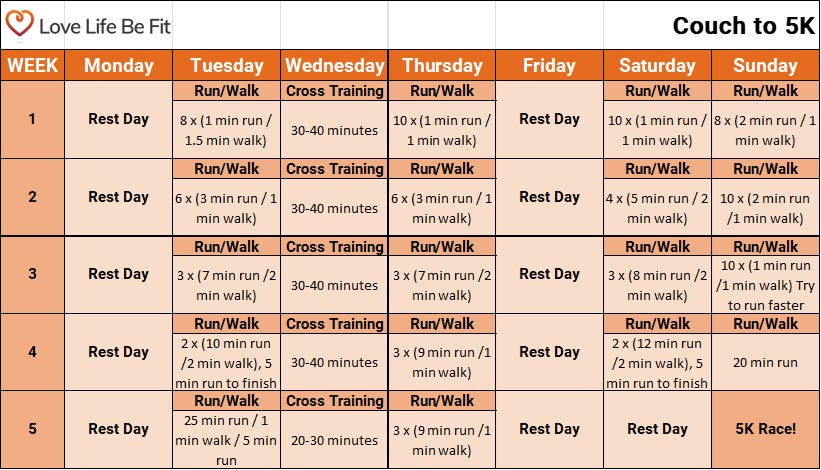How Many Miles Is 5K? Training Plan & Race Tips
This is it – the year you’re going to improve your fitness level. But how are you going to do it? Do you jump straight in and sign up for a half marathon? That’s a huge first step for a new runner! But what about a local 5k fun run?
5k races are a popular distance. It’s the shortest of the common distances for road races. Just about everyone can manage a 5k race distance with a little training.

But how long is a 5K in miles?
A 5K is 3.1 miles.
That’s a lot less than running a half marathon. If you’re wondering how many miles is a half marathon? It’s 13.1 miles. Now that’s a long way! It makes a lot more sense to choose a 5K as your first race. Nail your first 5k with this training plan.
If you’re completely new to running, 5K is still a daunting distance. But I’m going to show you how to make that distance a lot easier to conquer with the run/walk method and the Couch to 5K training plan.
Again, how many miles is 5K? 3.1 miles.
I’m sure everyone has walked 3 miles at some stage in their lives – sponsored walks at school maybe? Or maybe you already walk every day. If so, starting to run will be a lot easier.
If you’re new to exercise, have a lot of excess weight to lose, or haven’t exercised in a long time, it’s often best to start with a walking plan.
Why Should You Train For A 5K?
Training for a 5K is a way of tapping into all the amazing benefits of running:
- It’s a great way to stay fit and healthy.
- Running combined with a healthy diet is one of the best ways to lose weight.
- Running will help you live longer – yes really!
- It’s good for you – helps to improve your physical strength, boosts energy levels, strengthens your bones and muscles, and reduces the risk of developing certain chronic illnesses.
- Running is one of the best mood boosters and can help with sleep quality.
- You’ll love the changes to your body!
- Plus you’ll make a whole new circle of friends.

How Long Does It Take To Run A 5K?
Most new runners will take 30 to 40 minutes for a 5K. Advanced runners will aim to run a 5K in under 30 minutes, and many experienced runners set a target finish time of under 25 minutes.
But if you’re new to running, your goal is to get to the finish line. It’s enough of a challenge to run continuously for 3.1 miles without worrying about race times. Running faster can come later when you’ve completed at least one 5K race.
A good time depends on your age group, gender, and ability. Running Level is a good source of average running times. For fast runners, a good 5K time for a woman is 26.07 and for a man is 22.31.
If you’re a new runner or an older runner these times will sound fast! Remember these are averages and many runners will be a lot slower – especially in a fun run.
Can You Run A 5K Without Training?
It all depends on your current fitness level, your age, and whether you’re already active in other sports. For example, I’d expect a 19-year-old football player to make it around a 5K without training.
If you already take part in any cardio-related sport, you can probably run a 5K right now. You might be very stiff the next morning and struggle to get down any stairs. But it’s possible.
Yet it’s always better to do some training. There’s less risk of injury and your running times will be better.

Start Training
Proper training is the best way to get around a 5K successfully. But don’t worry! This guide will ease you into your running journey. You’ll start by alternating running and walking starting with really short intervals – just enough to get out of breath!
Step #1 Get Ready For Your First Run
If you haven’t exercised for a while or if you have any health issues, check in with a doctor before starting a running plan.
Running is such a natural sport. You don’t need a long list of gear for your first run:
- Good running shoes that fit.
- Comfortable running clothing.
- A 5K training plan! (Don’t forget 5K in miles is 3.1)
Step #2 Choose A Training Plan
Before you start running, the first thing you need to do is pick the right 5K training plan. If you’re a new runner, start with the Couch To 5K training plan. It’s a plan designed for a running newbie and takes you from no running experience to gradually running further every week until you can run for 30 minutes without stopping!
That’s enough to get you around your first 5K race.
The standard Couch to 5K is a 9-week plan but I’ve included a 6-week plan and even a 5-week plan if you’re starting from a higher fitness level.
You can complete your training outside on roads or footpaths, or inside on a treadmill.
Couch To 5K 9-Week Training Plan
This is based on the original Couch to 5K running plan.

Couch To 5K 6-Week Training Plan
A plan for new runners who have some fitness from other sports.

Couch To 5K 5-Week Training Plan
Already fit and up for a challenge? Try this 5-week plan…

Related post: Couch To 5K Plan (It Doesn’t Work For Everyone) an in-depth guide and everything you need to know about Couch to 5K.
Step #3 Pick A Race
Enter a race! It’s always best to have running goals and a race is the best way to stay motivated. Find a friendly local race or parkrun. A parkrun is a completely free-to-enter 5K race. 5K in miles is 3.1 miles!
5K is one of the most popular race distances so a suitable race should be easy to find. Pick one that leaves you with enough time to train!

Tips For Running Your First 5K
These training tips will get you to the finish line!
#1 Warm Up Properly
Always take time to warm up before training sessions or a race. Dynamic stretching with 5 – 10 minutes of walking or a light jog is the best way to start your training session.
#2 Be Flexible
A training schedule can be changed. If you find a week too hard – repeat a week. Get sick? Restart the schedule when you’ve recovered, right where you left off.
#3 Rest Days
Don’t get carried away as a new runner – rest and recovery are important. Some of your rest days can be active rest where you take part in low-impact exercises such as cycling or yoga.
Related post: Cross-training for runners.
#4 The Long Run
Key to most running plans is the long run. The Couch To 5K plans gradually build up to running longer distances and you’ll be running for 30 minutes non-stop by the end of the plan.
It’s important not to get carried away and try to run further. Doing too much too soon is a route to injury when you’re new to running. You want to get to the starting line for your race injury-free!
#5 Strength Training
It’s a good idea to include some strength training 2-3 times a week on your rest days. Building leg strength will make you a better runner and less prone to running injuries.
#6 Race Day
Make sure you arrive in plenty of time. It’s best to get your kit ready the night before to avoid any last-minute panics. Double-check start times!
Take a friend along to cheer you along or even better – find someone to run the race with you!
Related post: 12 Couch To 5K Tips For Beginner Runners

The Next Step
You’re no longer a novice runner – you’ve completed your first 5K race! So what’s next?
Concentrate on becoming a faster runner by adding interval training to your sessions. Or swap shorter races for longer races and gradually increase your race distance – 10K, half marathon, or even ultra running!
Running 101 Training Guides & Walking Schedules
5K Training Plans
- Couch To 5K Beginner Training Plan
- 12 Week 5K Training Plan
- 10 Week 5K Training Plan
- 8 Week 5K Training Plan
- 6 Week 5K Training Plan
- 4 Week 5K Training Plan
- 5K Training Plan Intermediate





